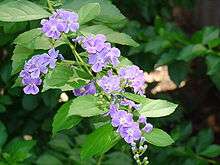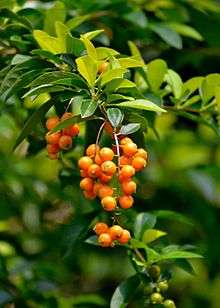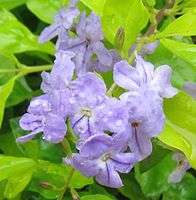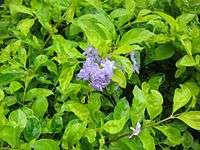Duranta erecta
| Duranta erecta | |
|---|---|
 | |
| Flowers | |
 | |
| Fruits | |
| Scientific classification | |
| Kingdom: | Plantae |
| (unranked): | Angiosperms |
| (unranked): | Eudicots |
| (unranked): | Asterids |
| Order: | Lamiales |
| Family: | Verbenaceae |
| Genus: | Duranta |
| Species: | D. erecta |
| Binomial name | |
| Duranta erecta L. | |
| Synonyms | |
|
Duranta repens L. | |
Duranta erecta is a species of flowering shrub in the verbena family Verbenaceae, native from Mexico to South America and the Caribbean. It is widely cultivated as an ornamental plant in tropical and subtropical gardens throughout the world, and has become naturalized in many places. It is considered an invasive species in Australia, China, South Africa and on several Pacific Islands. Common names include golden dewdrop, pigeon berry, and skyflower. In Mexico, the native Nahuatl name for the plant is xcambocoché.[1] In Tonga it is known as mavaetangi (tears of departure).
Description
_1200.jpg)
Duranta erecta is a sprawling shrub or (infrequently) a small tree. It can grow to 6 m (20 ft) tall and can spread to an equal width. Mature specimens possess axillary thorns, which are often absent on younger specimens. The leaves are light green, elliptic to ovate, opposite, and grow up to 7.5 cm (3.0 in) long and 3.5 cm (1.4 in) broad, with a 1.5 cm petiole. The flowers are light-blue or lavender, produced in tight clusters located on terminal and axillary stems, blooming almost all year long. The fruit is a small globose yellow or orange berry, up to 11 mm (0.43 in) diameter and containing several seeds.[2] The leaves and berries of the plant are toxic, and are confirmed to have killed children, dogs and cats.[3] However, songbirds eat the fruit without ill effects.[4]
Taxonomy
The genus name is in honor of Castore Durante, a fifteenth-century Italian botanist.[5] The specific epithet erecta means "upright" in Latin. The plant is also known as D. repens, from the Latin for "creeping". The latter name was originally used to identify smaller-leaved varieties of the species.[6]
Ecology
_1200.jpg)
Duranta erecta is native to the Americas, from Mexico and the Caribbean south to Brazil and Argentina. There is some debate about whether the plant is also native to the southern United States, in Florida, Louisiana, Texas, Arizona and California, or is an introduced species there.[7] In its natural state, it commonly grows in rocky or sandy coastal areas with full sun, or moister, disturbed sites inland. Prior to maturity, the plant will grow at a rate of up to half a meter per year.
Cultivation
Golden dewdrop is widely grown as an ornamental plant throughout tropical and warm subtropical regions.[4] Its showy flowers and fruit make it a desirable addition to gardens, and the blossoms attract butterflies and hummingbirds.[4] There are a wide variety of cultivars available, including 'alba', 'aurea', 'Aussie gold', 'gold mound', 'geisha girl', 'sapphire showers', and 'variegata'.[8]
Invasive potential
The plant has been identified as an environmental weed in Australia, South Africa, and China,[9] and is described as invasive in Hawaii, Fiji and French Polynesia.[10] It has been introduced to other habitats but has not become invasive.
Gallery
_1200.jpg) Duranta erecta
Duranta erecta Duranta Flowers
Duranta Flowers Duranta Bush
Duranta Bush
References
| Wikimedia Commons has media related to Duranta erecta. |
- ↑ O’Gorman, Helen. Mexican Flowering Trees and Plants. publisher:Ammex Associados, 1961
- ↑ Huxley, A., ed. (1992). New RHS Dictionary of Gardening 2: 117. Macmillan ISBN 0-333-47494-5.
- ↑ Thompson, N (2007). "Poisonous Plants in Australia: Enabling consumers to buy safe plants" (PDF). WWF-Australia: 10. Retrieved 2008-12-11.
- 1 2 3 Francis, John K. "Duranta erecta" (PDF). United States Forest Service. Retrieved 2008-12-11.
- ↑ "Duranta erecta". Missouri Botanical Garden. Retrieved 2008-12-11.
- ↑ Culbert, D. F. "Add drops of Gold to Florida Yards". University of Florida Institute of Food and Agricultural Sciences. Retrieved 2008-12-11.
- ↑ Christman, Steve (October 26, 2003). "Floridata: Duranta erecta". Floridata. Retrieved 2008-12-11.
- ↑ Culbert, D. F. "Duranta cultivars". University of Florida Institute of Food and Agricultural Sciences. Retrieved 2008-12-11.
- ↑ "Global Compendium of Weeds: Duranta repens". Hawaiian Ecosystems at Risk project. Retrieved 2008-12-11.
- ↑ "Pacific Islands Ecosystems at Risk: Duranta erecta". Hawaiian Ecosystems at Risk project. Retrieved 2008-12-11.
−
External links
- ITIS report on Duranta erecta
- USDA PLANTS database, Symbol DUER
- Durable, Dependable: Durantas! (San Diego Horticultural Society, via the Internet Archive)
- Dressler, S.; Schmidt, M. & Zizka, G. (2014). [http://www.africanplants.senckenberg.de/root/index.php?submitForm=true&page_id=77&searchTextMenue=Duranta+erecta&filterRegionIDs[]=6&filterRegionIDs[]=1&filterRegionIDs[]=2&filterRegionIDs[]=3&filterRegionIDs[]=5 "Duranta erecta"]. African plants – a Photo Guide. Frankfurt/Main: Forschungsinstitut Senckenberg.